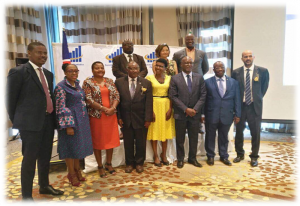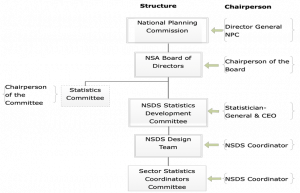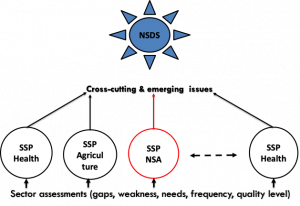- Reversing the declining trend in capacity for statistical production and their use especially for policy, planning, and decision-making in the country,
- Addressing nagging data challenges,
- Mobilizing and prioritizing the use of resources for statistical work,
- Transforming and modernizing the National Statistical System and, and
- Introducing and help to herald a “data revolution” into the country.
The NSDS is a process, an approach, and a product aimed at turning around the NSS. As a process, the design of the NSDS is country-specific owned and designed and should facilitate the following:
- Statistical advocacy by creating greater statistical awareness and literacy.
- Mainstream key stakeholders into the process by ensuring that the design process is participatory, inclusive, and uses a consensus-building approach.
- Empower both data producers, through capacity building and knowledge creation, and
- Broaden and deepen statistical coordination.
NSDS Process Launch
The NSDS process was officially launched in Windhoek on 30 October 2017 at a high-profile event officiated by the Minister for Planning and the CEO of the National Planning Commission, Hon. Tom Alweendo. The event was attended by about 60 participants including members of the NSA Board of Directors and representatives of government ministries, offices and agencies (MOSs); representatives of the private sector, civil society and development institutions and agencies. Both the African Development Bank and PARIS21 which are providing assistance to the NSDS process made strong statements of support to the process and to statistical development in the country.

Official Launch of the NSDS development process. Front row: from L-R: Mr. Salomo Hei (NSA Board member), Ms. Dennia Gayle (UNFPA representative), Prof. Nelago Indongo (NSA Board member), Prof. Ben Kiregyera (AfDB Consultant), Ms. Clareta Gamses (former NSA Board member), Hon. Tom Alweendo (Minister for Economic Planning and DG of NPC), Mr. Lawson Fessou Emessan (AfDB), and Mr. Rafik Mahjoubi (PARIS21). Back row: L-R: Mr. Alex Shimuafeni (Statistician-General and CEO of NSA), Ms. Izumi Morota-Alakija (UNDP Deputy Resident Representative), and Mr. Israel Tjizake (NSA Board member).
Design Approach
A sectoral or bottom-up approach is being used to design the. The NSDS will be a living document that will be reviewed and updated periodically as provided for in its Monitoring and Evaluation (M&E) system to respond to changing user needs and environment. This sectoral or bottom-up approach leverages specialized knowledge present in sectors, which can enhance inter-sectoral coordination. It also enables focusing statistical development efforts on improving administrative data extensively used in decision-making and monitoring national and international development initiatives.
- Selecting a limited number of sectors at the beginning to participate in the NSDS design process (usually key producers),
- Undertaking statistical advocacy in the sectors at the level of Leadership and Management to create more awareness and secure buy-in;
- Assessing the state of statistics in each sector;
- Formulating Sector Statistics Plans (SSPs) and
- Using the SSPs as building blocks for designing the overall NSDS (see Figure 1).
Design and Management Framework
The nature and scope of the NSDS are such that it cannot be effectively designed and managed using existing NSA structures. It, therefore, needs a dedicated structure. The proposed NSDS design and management structure are presented in the Figure below. While emphasizing the need to use existing structures as much as possible, there will be a need to set up some ad-hoc structures to supplement existing ones to enable smooth design and management of the NSDS.

In the context of the NSDS, a sector is defined as “A vertical division of governmental focus that relates to a given subject area or public need – usually corresponding to line ministries, government departments or agencies – with separate and well-defined areas of concern, mandate, and budget”.. More sectors will be added as experience is built up, and the process is scalable.

NSA Board of Directors
The NSA is an autonomous government agency with a Board of Directors as its governing body. The Board has members drawn from a broad range of stakeholder groups and is answerable to the Minister of Statistics who is the Director-General of the National Planning Commission. The Board is responsible for setting policies; approving NSA structures, work programme, and budget; etc. This structure should be used to formulate appropriate policies and/or approve arrangements for the NSDS design and management process including the NSDS design roadmap and design structures. It should also approve the Sector Statistics Plans as well as the NSDS and its implementation plan.
Statistics Development Committee
The SDC is established and chaired by the Statistician-General. It should comprise sectors participating in the NSDS design process represented by high-level officials from the sectors (at Deputy Directors and above or Managers). This Committee should meet every quarter and report to the Board of Directors.
- Reviewing and discussing work in progress and set benchmarks;
- Reviewing and consolidating sectoral outcomes; identifying gaps and feeding them back to the sectors;
- Reviewing planned outputs in line with international experience, guidelines, standards, frameworks, and concepts;
- Proposing modalities for feedback to sectors;
- Determining the nature and schedule meetings/workshops required during the NSDS design and implementation process;
- Agreeing on reporting mechanisms for the NSDS;
NSDS Design Team
The NSDS design team is established by the Statistician General. The team consists of 3 to 4 officials from the NSA and should be headed by an NSDS Coordinator.
- spearheading the design of the NSDS following internationally agreed standards, initiatives, and best practices;
- mobilizing and sensitizing sectors about the strategic planning process for statistics;
- supporting sectors in undertaking statistical advocacy;
- identifying core products and data gaps;
- doing a quality assessment of existing data in sectors; supporting the integration of statistics from the different sources (censuses, surveys, and administrative sources) into a comprehensive database;
- promoting internal technical coordination in the production of statistical information and the building of team spirit;
- providing for the interface between data users and producers to agree on data priorities and timely production and use of relevant statistical products;
- supporting the review and formatting of sector plans according to agreed standards and identifying areas with duplication of effort;
- providing a platform for sharing experiences and lessons of the process during the Inter-Agency Technical Committee meetings; and
- identifying existing capacity gaps in the sectors that call for technical backstopping by the NSA.
Sector Statistics Coordinators Committee
For each sector participating in the NSDS process, a Sector Statistics Committee should be established. The committee should be headed by a Sector Statistics Coordinator. Both the committee and the Coordinator should be designated by the leadership of the sector, in this case, the Permanent Secretary or Chief Executive Officer.
- advocate for statistics in the sector (with support from the NSDS design team);
- identify major data needs related to the sector for informing sectoral policies, national development agenda, and achievement of regional and international goals;
- prepare a formal inventory of the different data systems being operated by the different stakeholders in the sector;
- identify major offices in the sector currently collecting or compiling statistics;
- identify data gaps and priorities for addressing them in line with the sectoral policies, national and international goals;
- identify data collected, methodology and procedures used, coverage, availability and access, levels of disaggregation, data quality, frequency of updating, and utility;
- closely work with the NSDS design team and consultants as per the work plan to:
- conduct a stakeholder analysis;
- identify the strengths, weakness, opportunities, and threats (SWOT) of institutional statistical units/sections in line with those of the NSS;
- develop vision, mission statements, and core values for statistical provision in the sector; and
- develop Sector Statistics Plans;
- Develop strategic actions: organizational development, human resource development, IT infrastructure development, data improvement and management, monitoring, evaluation and reporting; and budget development in the sector and any other issues as requested by the Inter-Agency Technical Committee; and
- Present the plan at the sectoral level to build consensus and prepare the final report to be submitted to the NSA Board of Directors for approval.
Participating Sectors
| NO | SECTOR | COORDINATORS | SECTOR STATISTICS PLAN |
|---|---|---|---|
| 1 | Ministry of Basic Education, Art and Culture (MoEAC) | Vacant | Draft |
| 2 | Department of Environment in MET | Mr. Veikko Shigwedha | Draft |
| 3 | Department of Tourism in MET | Mr. Abner Nambahu | Draft |
| 4 | Directorate of Customs & Excise in MoF | Mr. Severus Kankondi | Draft |
| 5 | Directorate of Inland Revenue in MoF | M. Kenneth Haludilu | Draft |
| 6 | Ministry of Gender Equality and Child Welfare (MGECW) | Mrs. Brigitte Nshimyimana | Draft |
| 7 | Ministry of Health and Social Services (MoHSS) | Ms. Emmy-Else Ndevaetela | Draft |
| 8 | Ministry of Industrialisation, Trade and SME Development (MITSMED) | Ms. Annalisa Amweelo | Draft |
| 9 | Ministry of Labour, Industrial Relation and Employment Creation (MLIREC) | Ms. Annalisa Amweelo | Draft |
| 10 | Department of Agriculture in MAWF | Mr. Sanda Stephanus | Draft |
| 11 | Namibia Statistics Agency (NSA) | Mrs. Anastasia Johannes | Draft |
